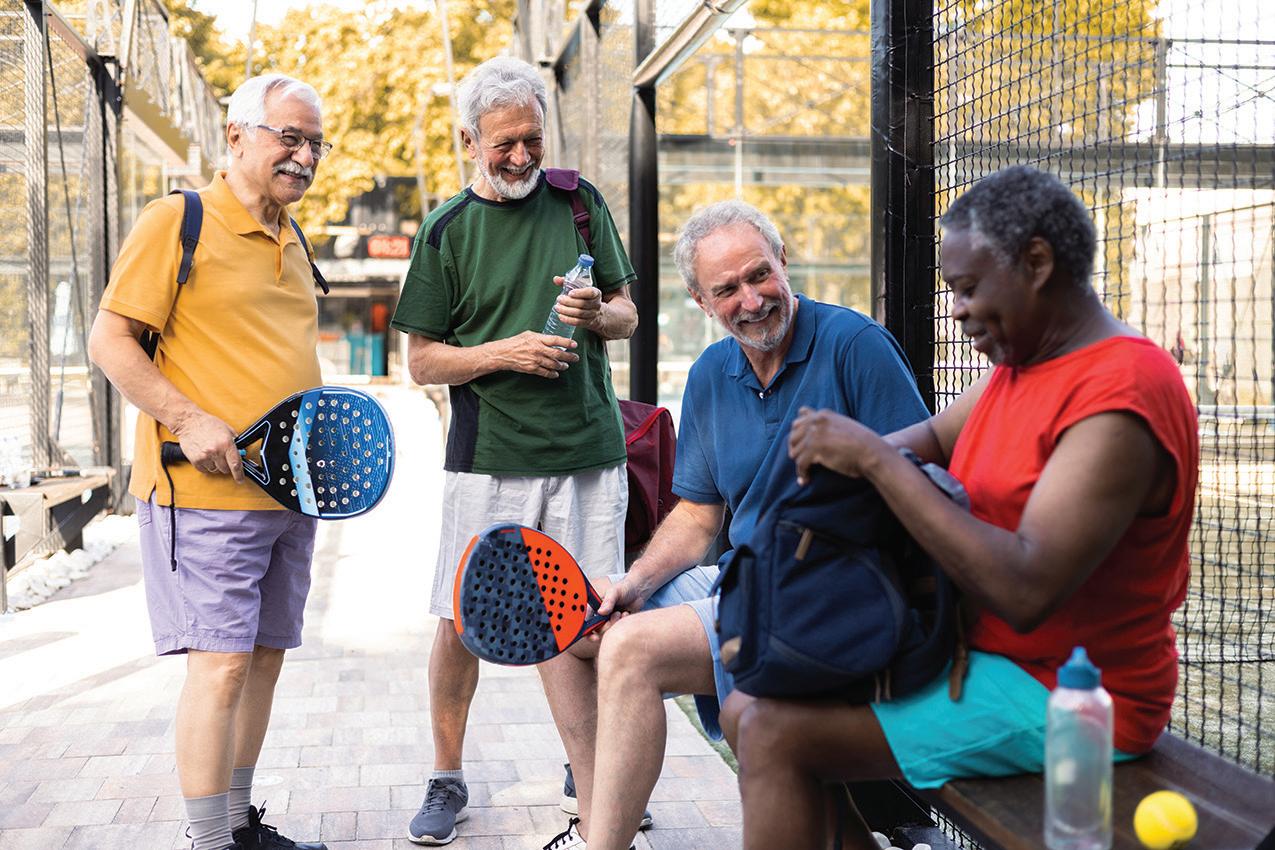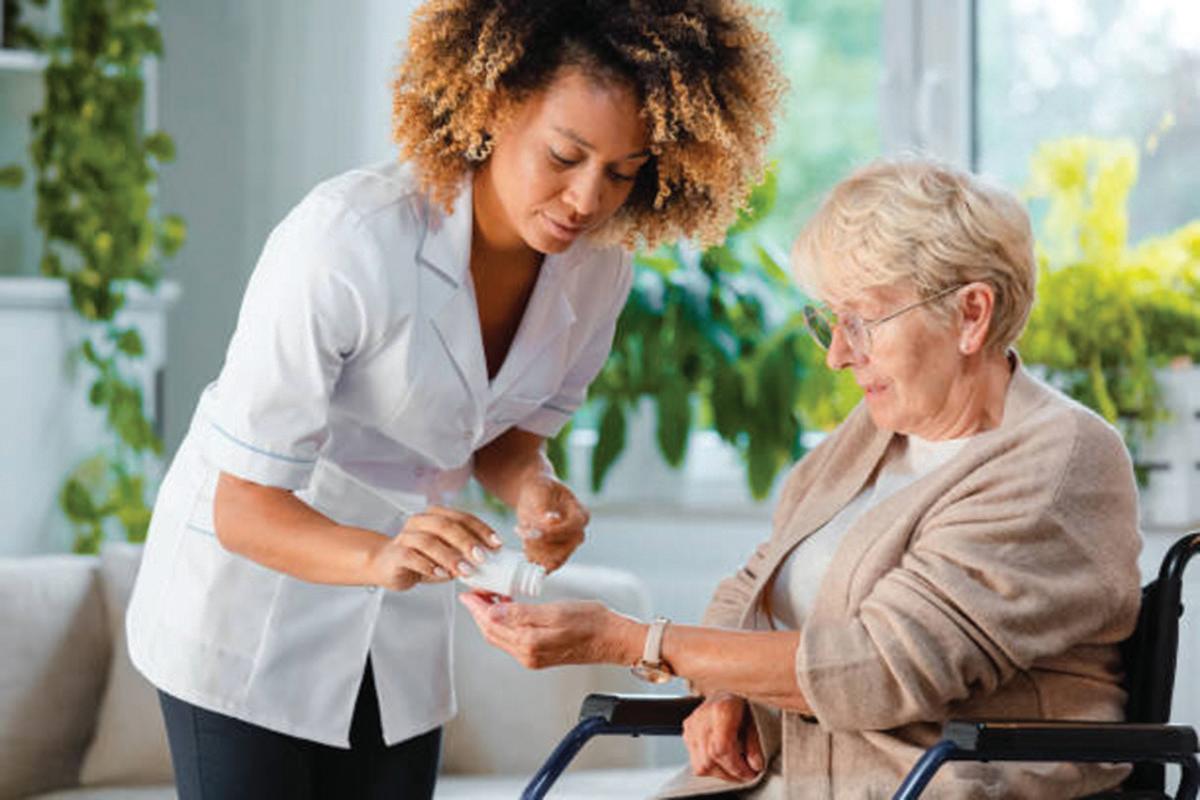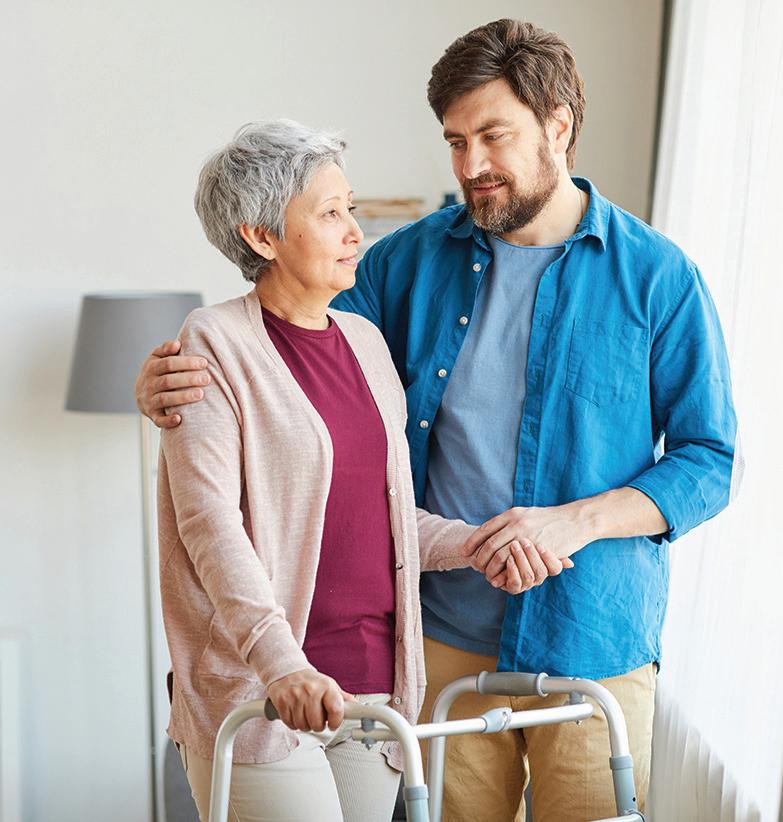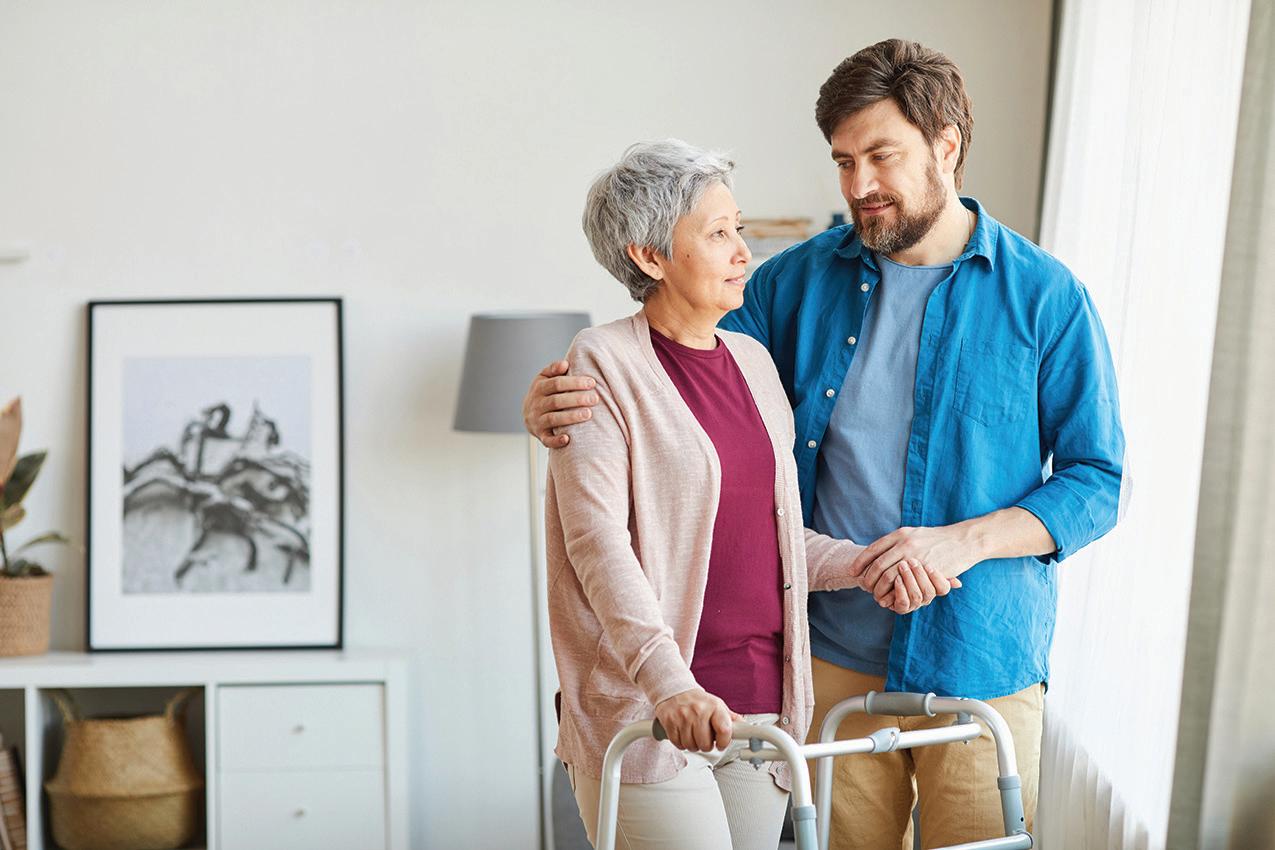Tips to prevent PICKLEBALL injuries
Pickleball has inspired millions of devotees. According to the Association of Pickleball Professionals, roughly 36.5 million individuals played pickleball in 2022, and 45 percent of players who participated in a YouGov study conducted between August 2021 and August 2022 indicated they planned to play more pickleball in the coming six months than they had in the previous six months.
Pickleball is thriving, and that’s great news for those who love the game. Unfortunately, pickleball also has proven beneficial to orthopedic practices. A 2023 analysis from UBS estimated pickleball injuries could cost Americans nearly $400 million in 2023. Seniors are especially vulnerable to pickleball injuries, as a 2021 study published in the journal Injury Epidemiology found that 86 percent of emergency room visits related to pickleball injuries affected individuals 60 and older.

minutes before a game and use that time to loosen up. A short walk and some subsequent stretches can help players make sure their bodies are not too tight to play. Some brief warm-up exercises and stretching can reduce muscle tension and make the body less vulnerable to injury.
• Gear up. Pickleball is a competitive sport, but there’s a tendency among some players, particularly novices, to take a casual approach to the game. Veteran players may know better, but anyone new to the game should be sure to wear the
Injuries are a part of any sport, and pickleball is no different. Though there’s no foolproof method to guarantee pickleball players don’t get hurt playing the game they love, the following are some tips that can reduce injury risk.
appropriate gear when playing. Athletic shoes with ample traction can reduce the likelihood that players will slip or fall. The right racket also can reduce risk for elbow injuries. The sporting goods experts at Dick’s Sporting Goods note that paddles should feature a light to medium weight, comfortable grip
and a large sweet spot. The right paddle will be different for everyone, so novices are urged to speak to veteran players for advice on which paddle might be best for them.
• Embrace physical activity. Pickleball can be a great workout, and players can reduce their injury risk by embracing
physical activity even when they are not playing. Leg exercises can help build lower body strength, but strength exercises that focus on the upper body also can reduce injury risk.
• Loosen up before playing. Taking the court right after getting out of the car is a recipe for injury. Arrive five to 10
• Hydrate before, during and after a game. The experts at Johns Hopkins Medicine note that water cushions the joints, which helps athletes maintain their flexibility. Flexibility can reduce injury risk, particularly in a sport like pickleball. The 2021 study published in Injury Epidemiology noted that 60 percent of pickleball injuries are sprains, strains or fractures. Remaining flexible can reduce athletes’ risk for sprains and strains. Johns Hopkins recommends adults consume between six and 12 ounces of water for every 20 minutes of sports play and to drink between 16 and 24 ounces afterward. Pickleball is wildly popular, even though pickleball injuries are common. Players can embrace various strategies to reduce their injury risk.


Senior Living
The nutritional benefits of BLUEBERRIES
Are you ready to dig into a bowl of delicious blueberries? Perhaps you’re adding a handful to your morning smoothie? Regularly eating blueberries is not only tasty, it can be excellent for your overall health.
While the term “superfood” has become controversial because it is now seen as a marketing ploy and there’s no standardized list of criteria to designate a food as “super,” blueberries have often been touted as especially nutritious. That’s because blueberries are not only low in calories, they’re full of nutrients the body needs to thrive.
Healthline indicates blueberries are among the most nutrient-dense berries. A cup contains only 85 calories, and in that serving a person can

enjoy 3.6 grams of fiber, 16 percent of the daily value (DV) of vitamin C; 24 percent of the DV of vitamin K; and 22 percent of the DV of manganese.
One of the main benefits of blueberries is that they are rich in antioxidants. Produced as a natural result of metabolism or exposure to pollution,
cigarette smoke and alcohol, free radicals are molecules that damage cells over time. Antioxidants create barriers around cells to help protect them
from damage by free radicals.
The Cleveland Clinic says that the high soluble fiber content of blueberries can make them strong allies in the fight against cholesterol. Soluble fiber binds to bile in the gut. Bile is made of cholesterol and other substances that need to be removed from the body. Lowering cholesterol helps prevent or reduce risk of heart disease.
In relation to heart health, blueberries also may help reduce blood pressure, which can be beneficial for the heart and brain. Healthline reports that in an eight-week study, people with obesity who had high risk of heart disease noted a 4 to 6 percent reduction in blood pressure after consuming two ounces of freeze-dried
How families can share caregiving responsibilities
blueberries per day. Additional studies have uncovered similar blood pressure-lowering abilities of blueberries.
Individuals concerned with keeping their brains sharp may want to consider adding blueberries to the mix of foods they eat regularly. A study in The American Journal of Clinical Nutrition uncovered cognitive function improved when participants ate about 3⁄4 cup of blueberries per day.
BBC Good Food says blueberries also are low in sugar and high in fiber, which gives them a low glycemic index. This means blueberries can potentially control blood sugar levels.
Blueberries are powerhouses of nutrition and people of all ages can benefit from consuming them regularly.
Family caregivers are unsung heroes. Such individuals typically provide vital services to their loved ones who cannot fully care for themselves, and they often do so without compensation.
Data from the U.S. Bureau of Labor Statistics indicates the prevalence of family caregivers across the country. According to the BLS, 14 percent of the population, which equates
to roughly 37 million people, provide unpaid eldercare across the nation.
Unpaid caregivers also provide vital services in Canada, where the Canadian Institute for Health Information reports such individuals provide an average of 17 hours of unpaid care each week (26 hours for those who care for seniors with dementia). Caregiving for a family member can take a

toll that affects caregivers’ physical and mental health. According to the Centers for Disease Control and Prevention, caregivers are at increased risk for developing multiple chronic diseases since many neglect their own health needs while caring for others. In addition, roughly 15 percent of caregivers who participated in a CDC survey reported experiencing 14 or

more mentally unhealthy days in the past month.
The physical and mental toll of caregiving underscores how important it can be for families to find ways to share caregiving duties. Though each situation is unique, the National Institute on Aging offers the following advice to families as they seek to share the responsibility of caring for a loved one in need.
• Identify the care required. The NIA recommends families discuss caregiving needs as early as possible and ideally before an emergency situation arises. If possible, the person in need can participate in this conversation and help to calmly discuss which services are wanted and needed. If a loved one is diagnosed with a condition in its early stages, such as dementia, families can then work together to identify the level of care required in the immediate future and potentially down the road should the condition worsen.
• Choose a primary caregiver. The primary caregiver will be the individual who accepts the bulk of the daily responsibilities of caregiving. Identifying this person early, ideally before a primary caregiver is even needed, can limit confusion should the day come when the individual needs daily care.
• Determine each

caregiver’s contribution. The caregiving team can discuss each person’s skills and how they can be used to take care of the individual in need. This can be particularly useful when assigning specific tasks. For example, a caregiver who works in the medical field may be most qualified to speak to medical staff about their loved one’s condition, while another who works in the financial sector may be tasked with managing a loved one’s bank accounts and ensuring bills are paid on time.
• Recognize everyone has limits. A caregiving team is just that: a team. As noted, caregiving can take both a physical and
emotional toll, so it’s important that everyone, and particularly the individual chosen as the primary caregiver, receive routine breaks to ensure everyone can take care of themselves. It’s important that a caregiving team maintain a degree of flexibility to account for the physical and mental challenges caregivers may encounter as they tend to a loved one in need.
Sharing the responsibility of caregiving can ensure caregivers and their loved ones in need are not overwhelmed by the challenges they might confront each day. More information about caregiving can be found at nia. nih.gov.






The role of a home health aide
Caregivers come from all walks of life. Doctors and nurses may be the frontline medical providers people encounter most frequently, but there are plenty of others who do their part to maintain the well-being of individuals, including home health aides.
Home health aides, sometimes called personal care aides, are brought in to assist a person with activities of daily life. An HHA typically helps a person who may need some assistance with tasks they cannot perform due to illness or disability. HHAs may work in a person’s home, in a group home or in another care facility.
AARP says home health
aides are considered health care paraprofessionals and must meet established training requirements, which vary by location.
HHAs may perform various duties, including:
• assistance with personal care, such as dressing, toileting, feeding, and moving from bed to chair, etc.
• checking vital signs
• monitoring a client
• light housekeeping
• meal planning and cooking
• picking up prescriptions
• companionship
HHAs typically will not provide skilled nursing care and may not be able to offer recommendations on treatment or medications. Individuals can find the

of HHAs who may work independently or are placed through agencies. Sometimes a doctor
Preventing over-medication
Polypharmacy, the simultaneous use of multiple medications by a patient, has become increasingly common among seniors and can pose significant risks to their health and well-being.
While medications are often prescribed to manage chronic conditions and improve quality of life, the complexity of managing multiple prescriptions can lead to adverse drug reactions, medication errors and other complications. Seniors are particularly vulnerable to polypharmacy due to age-related changes in metabolism, increased likelihood of chronic health conditions and frequent use of multiple health care providers.
The National Library of Medicine defines polypharmacy as using five or more medications. They say it is more common among seniors because as people age they are more likely to have multimorbidity, or the presence of two or more chronic health conditions. These conditions often require competing treatment plans. The number five is linked to the point at which there is a higher risk of adverse
outcomes such as falls, frailty, disability and mortality. Seniors with increased risk of over-medication include those who have multiple doctors and specialists prescribing medication, live with chronic mental health conditions or are residing in a long-term care facility such as a nursing home. Some of the causes of over-medicating include having poorly updated medical records, automated refill services and prescribing to meet disease-specific quality metrics, according to American Family Physician. Effective medication management ensures the safe and appropriate use of medications. One key strategy is medication reconciliation, which involves creating a comprehensive list of all medications a senior is taking, including prescription drugs, over-thecounter medications, vitamins and supplements. A health care provider regularly reviews and updates this list to identify potential drug interactions, duplications or other issues. Seniors should communicate openly with their health care providers about
any concerns or side effects they may be experiencing, as well as any changes in their medication regimen. Furthermore, seniors can benefit from regular medication reviews with their health care team to assess the continued need for each medication, evaluate its effectiveness and identify opportunities to simplify the regimen or eliminate unnecessary medications. Pharmacists can play a valuable role in this process by conducting comprehensive medication reviews, identifying potential drug-related problems and providing education and support to seniors and their caregivers. Additionally, seniors should be educated about the importance of adherence to their medication regimen, including proper dosing schedules, storage requirements and potential side effects. By actively engaging in their own care and working closely with their health care providers, seniors can reduce the risks associated with polypharmacy and optimize the management of their medications for improved health outcomes and quality of life.



or hospital will have connections to HHA services and can make referrals. It can be useful to interview several potential HHAs to find one who will fit with the needs and personality of the person requiring assistance. A good HHA will be compassionate, patient and flexible. As illness or injury also can affect a person’s mood, HHAs must be able to adjust if a client is reluctant to receive help or is depressed or anxious from his or her limitations.
Home health aides serve vital roles in the health care community by providing care and companionship to those who can no longer live independently.
Did you know?
A cataract is a clouding of the naturally transparent lens of the eye that can occur as one ages. Natural proteins in the lens clump together and can cloud the eye.
The National Eye Institute says most cataracts develop with age, as more than half of all Americans age 80 or older either have cataracts or have had surgery to remove them. But cataracts can occur for other reasons, such as after an eye injury or after surgery for another vision problem.
The American Academy of Opthalmology says cataracts can make it seem like a person is looking through a foggy or dusty car windshield. Everything is hazy, blurry or less colorful. Additional vision changes associated with cataracts include extra light sensitivity; seeing bright colors as faded or yellowed; seeing double or a ghosted image; and difficulty seeing at night.
Using brighter lights at home or getting a new eyeglasses prescription can help manage cataracts in their early stages. An eye doctor may suggest surgery if cataracts are getting in the way of daily activities. Surgery removes the clouded lens and replaces it with a new, artificial lens.

Senior Living
SUNDAY, MAY 26,
Are there ways to prevent Alzheimer’s disease?
Researchers around the globe continue to investigate Alzheimer’s disease, the most commonly diagnosed form of dementia. The Centers for Disease Control and Prevention says Alzheimer’s disease (AD) is a progressive form of dementia that affects around 6.5 million people in the United States. Since AD affects parts of the brain that control thought, memory and language, notable symptoms include memory loss and difficulties communicating.
AD can be a debilitating condition, so naturally people want to do all they can to avoid it. Right now there are no proven prevention strategies nor a cure. However, the Mayo Clinic says there is strong evidence that healthy lifestyle habits may play a role in reducing AD risk, as well as risk for other types of dementia. The Alzheimer’s Association

Retirement withdrawal strategies
You’ve spent decades savings and retirement has arrived — now how do you manage your hard-earned nest egg?
Planning for retirement involves not only saving diligently during your working years but also devising a thoughtful withdrawal strategy to sustain your financial well-being throughout your golden years. As seniors transition from the accumulation phase to the distribution phase of their retirement savings, designing an effective withdrawal plan becomes paramount.
Seniors typically have a mix of retirement accounts, including traditional IRAs, Roth IRAs, 401(k)s, pensions and Social Security benefits. Each type of account has its unique tax treatment and withdrawal rules, which can affect the timing and tax implications of withdrawals.
Sequence of withdrawals
There is no one single withdrawal strategy because every person has different needs, resources and time considerations. However, there are some general guidelines that can start as a foundation and be adapted accordingly.
Determining the sequence of withdrawals from various retirement accounts optimizes tax efficiency and preserves the longevity of your savings.
As a general rule of thumb, seniors may consider tapping into taxable accounts first, followed by tax-deferred accounts like traditional IRAs and 401(k)s, and tax-free accounts like Roth IRAs. Financial advisors from Edelman Financial Engines told AARP that the reason for this sequence is that drawing from the tax-deferred bucket increases your taxable income and can increase your tax bracket, which then can increase your Medicare premiums. By drawing from taxable accounts, you are letting investments in the tax-deferred and tax-free accounts continue to grow.
They do warn that if you retire early and are receiving a subsidy for Affordable Care Act health insurance coverage, you’ll want to be careful about what you withdraw from taxable accounts because you could lose that subsidy.
Calculating annual withdrawal rates
Determining how much to withdraw from retirement accounts each year requires careful consideration of factors such as anticipated

living expenses, health care costs, inflation, investment returns and life expectancy.
Financial planners often recommend adhering to a sustainable withdrawal rate, typically around 3% to 4% of the total retirement portfolio, adjusted for inflation annually. By adopting a conservative withdrawal rate, seniors can mitigate the risk of outliving their savings and maintain financial stability throughout retirement.
Seeking professional advice
Navigating the complexities of retirement planning and withdrawal strategies can be daunting, making it essential for seniors to seek guidance from qualified financial advisors or retirement planners.
A financial advisor can help assess individual financial circumstances, develop personalized withdrawal strategies, optimize tax planning strategies and provide ongoing portfolio management and monitoring.
Working with a professional advisor can provide seniors with peace of mind and confidence in their retirement plan’s viability.
Flexibility and adaptability
Even the best plans often have to change once they are put into action. Seniors should remain flexible and adaptable to unforeseen changes in financial markets, health care needs and personal circumstances.
Periodically reassessing and adjusting withdrawal strategies in response to evolving needs and market conditions can help seniors stay on track toward their long-term financial goals and address unexpected challenges effectively.
Planning ahead and making informed decisions today can pave the way for a fulfilling and worry-free retirement journey in the years ahead.
studies show that as many as 80 percent of individuals with AD also have cardiovascular disease. Lowering blood pressure and cholesterol levels may, in turn, help individuals reduce their risk for AD.
• Eat a balanced diet. Many doctors recommend the Mediterranean diet, which is rich in vegetables, fruits and lean protein coming from sources containing omega-3 fatty acids. This diet also is heart-healthy.
• Embrace physical activity. Regular physical activity may lower the risk of AD as well as vascular dementia. Exercise can boost blood and oxygen flow in the brain. Cardiovascular exercise is an essential part of any wellness plan.
• Quit smoking. Quitting smoking can help
Everyone experiences loneliness throughout life, but it can become particularly acute among older people who face social isolation due to retirement, loss of loved ones or physical limitations.
According to a National Poll on Healthy Aging conducted by the University of Michigan, one in three adults aged 50-80 reported feeling isolated from others, having a lack of companionship and having infrequent contact with people from outside their home. This is down from the height of the pandemic years, but still higher than pre-pandemic levels.
They also found that loneliness factors are particularly high among people with poor physical or mental health, those who have a disability that limits daily activities, those who do not work, those who live alone, people aged 50-64 and women.
However, there are several strategies seniors can employ to combat loneliness and cultivate a sense of connection and fulfillment in their lives.
Firstly, maintaining social connections is crucial for preventing loneliness. Seniors can proactively seek out opportunities to engage with others by joining community groups, clubs or senior centers where they can participate in activities that align with their interests. These social gatherings provide opportunities for seniors to meet like-minded individuals and foster new friendships, helping to alleviate feelings of isolation. Additionally, staying connected with family and friends is essential for combating loneliness. Seniors can try to regularly reach out to loved ones through phone calls, video chats or in-person visits if possible. Building and nurturing these relationships can provide emotional support
maintain brain health and reduce the risk for various diseases.
• Avoid head injuries. Always wear protective safety equipment when participating in sports or while riding motorcycles or other motorized vehicles. Fall-proof your home and wear seatbelts while riding in cars.
• Maintain social connections and activity. A number of studies indicate that maintaining strong social connections and keeping mentally active as people age might lower the risk of cognitive decline as well as AD.
• Keep a healthy weight. Manage weight through diet and exercise.
Although there is no guaranteed way to avoid a dementia diagnosis, certain lifestyle changes may help people reduce their risk.
and companionship, even from a distance.
Engaging in meaningful activities and hobbies can also help seniors ward off loneliness. Whether it’s pursuing a longtime passion, learning a new skill or volunteering in the community, staying active and engaged can provide a sense of purpose and fulfillment. Seniors can explore activities that bring them joy and fulfillment, whether it’s gardening, painting, playing musical instruments or participating in group exercise classes. Furthermore, taking care of physical health is crucial for overall well-being and can have a positive influence on mental and emotional health. Seniors should prioritize regular exercise, a balanced diet and sufficient sleep to maintain optimal physical and mental health. Exercise not only improves physical fitness but also releases endorphins that boost mood and reduce stress and anxiety. Seeking professional support is another valuable resource for seniors struggling with loneliness. Mental health professionals, counselors or support groups can provide guidance, coping strategies and a safe space to discuss feelings of loneliness and isolation. Seniors should not hesitate to reach out for help if they’re experiencing persistent feelings of loneliness or depression.
AARP recently compiled a list of several low-cost activities seniors could do to stave off loneliness. These included: organizing a reunion, taking a trip, volunteering, walking your dog, visiting a house of worship, seeking out intergenerational connections, reaching out to strangers, hosting a cocktail party, organizing a book swap, renting out a spare room and taking a free online class.
Seniors and video gaming
Video gaming is a pasttime for all ages. The first video game, “Spacewar!” was created more than 60 years ago and even “Pong” recently celebrated its 50th birthday — meaning many of today’s seniors have been playing video games for much of their lives.
Video gaming offers numerous benefits and unique challenges. Older adults have access to a wealth of opportunities for entertainment, socialization and cognitive stimulation within the world of video gaming.
Benefits of gaming for seniors
Engaging in video games can sharpen cognitive functions such as memory, attention and
problem-solving skills. Strategy-based games and puzzles challenge seniors’ mental acuity and provide a stimulating mental workout.
Online gaming platforms enable seniors to connect with friends, family and fellow gamers from around the world.
Multiplayer games foster social interaction, camaraderie and a sense of community, combating feelings of loneliness and isolation.
Gaming serves as a form of relaxation and stress relief for seniors, offering an immersive escape from daily worries and anxieties. Engaging in enjoyable gameplay can elevate mood, reduce tension and promote overall well-being.
Playing video games enhances hand-eye coordination and fine motor skills, particularly in seniors who may experience age-related decline in dexterity and reflexes. Interactive gameplay exercises manual dexterity and promotes physical agility. From immersive storytelling experiences to casual puzzle games, seniors find joy and entertainment in a diverse array of gaming genres. Video games provide endless opportunities for exploration, adventure and creative expression, catering to a wide range of interests and preferences.
Concerns of seniors regarding gaming
Extended periods of gaming may lead to physical discomfort or strain, particularly for seniors with pre-existing musculoskeletal conditions or mobility issues. Proper ergonomics and regular breaks are essential to prevent discomfort or injury.
Seniors may encounter challenges navigating gaming interfaces or mastering complex game mechanics, especially if they’re less familiar with technology. Patient guidance and support from family members or caregivers can help seniors overcome technological barriers and enjoy gaming experiences. Excessive screen time can have negative effects on seniors’ vision, sleep quality and
overall health. Establishing healthy screen time habits and balancing gaming with other activities is crucial for maintaining well-being. Seniors should exercise caution when purchasing or downloading games, as excessive spending on in-game purchases or subscriptions can strain limited budgets. Practice responsible spending habits and ensure sound financial literacy when engaging in gaming.
Favorite games
Some types of games that are popular among seniors include: • Casual puzzle games: Sudoku, crossword puzzles, and matchthree games are popular choices among
seniors for their simplicity, accessibility and brain-teasing challenges.
• Simulation games: Simulation games such as “Farming Simulator,” “The Sims” and “Animal Crossing” appeal to seniors’ interests in virtual world-building, creativity and relaxation.
• Classic arcade games: Nostalgic arcade classics like “Pac-Man,” “Tetris” and solitaire evoke fond memories of arcade gaming and offer timeless gameplay experiences for seniors.
• Strategy and board games: Seniors enjoy strategy-based games like chess, mahjong, and card games, which stimulate critical thinking, strategic planning and social interaction.
Finding your inner artist
Engaging in creative workshops offers seniors a rewarding outlet for self-expression and personal growth. These artistic pursuits provide a creative outlet and therapeutic benefits that can enhance overall well-being.
For seniors, participating in creative workshops offers a unique opportunity to explore new interests and hobbies in a supportive and stimulating environment. Many communities offer workshops and classes specifically designed for seniors, providing a welcoming space where individuals can learn new skills and connect with like-minded peers.
Types of workshops
Pottery, for example, is a popular creative activity that allows seniors to work with their hands and create beautiful, functional pieces of art. From shaping clay on a pottery wheel to hand-building techniques like coiling and pinching, pottery offers a tactile and meditative experience that can
promote relaxation and stress relief. Seniors can explore their creativity through sculpting unique forms, experimenting with different glazes and expressing themselves through their work. Similarly, glassblowing workshops offer seniors the opportunity to work with molten glass and create stunning glass objects such as vases, bowls, and ornaments. While glassblowing requires precision and skill, it also encourages seniors to embrace the spontaneity and fluidity of the medium, fostering a sense of creativity and experimentation. Working with glass can be both physically and mentally engaging, providing seniors with a fulfilling and dynamic artistic experience.
Other glass-related art includes fused glass, etched glass, cast glass and stained glass. Woodworking is another popular creative pursuit that appeals to seniors who enjoy working with their hands and creating tangible objects. From carving and shaping wood

to assembling intricate pieces of furniture, woodworking allows seniors to explore their craftsmanship and bring their creative visions to life. Woodworking workshops often provide access to professional tools and equipment, as well as expert guidance and instruction to help develop skills and build confidence. In painting workshops, seniors can explore color and form, unleashing
their creativity on canvas or paper. From watercolor and acrylic painting to oil and mixed media techniques, painting offers a versatile and expressive medium through which to communicate emotions and experiences. Seniors can experiment with different painting styles and techniques, from impressionism and abstract art to realism and landscape painting, allowing them to find their own unique
artistic voice. For seniors interested in more industrial forms of creativity, metalworking workshops offer a handson and dynamic experience that combines craftsmanship with technical skill. From forging and welding to metal sculpture and jewelry making, metalworking allows seniors to work with a diverse range of materials and techniques to create functional and decorative
objects.
Seniors can learn the art of shaping and manipulating metal, from hammering and soldering to casting and engraving, gaining a deeper understanding of the properties and possibilities of this versatile medium.
Benefits
Participating in creative workshops can have a range of positive effects on seniors’ overall well-being. Engaging in artistic activities has been shown to reduce stress, alleviate symptoms of anxiety and depression and improve cognitive function and memory. Creative expression can foster a sense of purpose and accomplishment, boost selfesteem and enhance social connections with fellow workshop participants.
In addition to the therapeutic benefits, creative workshops offer seniors the opportunity to learn new skills, challenge themselves and pursue lifelong passions and interests.
Understanding Medicare gaps
Medicare goes a long way to helping seniors manage their healthcare, but it doesn’t cover all possible health care costs. Knowing what is not covered can help seniors plan ahead before the need for an uncovered type of care arises. This knowledge acts as an essential tool for comprehensive financial planning and well-being.
Hearing aids
Medicare typically does not cover hearing aids or routine hearing exams, leaving many seniors to bear the full cost of these essential devices. To address this gap, seniors may explore alternative options such as purchasing supplemental insurance plans that offer hearing aid coverage or researching community programs that provide financial assistance for hearing aids.
Eye exams
Routine eye exams, eyeglasses and contact lenses are not covered by Medicare, except in certain circumstances such as diabetic eye exams or cataract surgery. Seniors can consider enrolling in vision insurance plans or exploring discounted vision programs offered by organizations like AARP to help offset the cost of eye care services.
Dental work
Medicare does not cover
most dental procedures, including routine cleanings, fillings and dentures. Seniors may need to purchase separate dental insurance plans or seek out low-cost dental clinics and discount programs to access affordable dental care. Some Medicare Advantage plans offer limited dental coverage as an added benefit.
Overseas care
Medicare typically does not cover health care services received outside of the United States, except in rare emergency situations or specific circumstances. Seniors who travel frequently or reside part-time in other countries may need to consider purchasing travel insurance or international health insurance to cover medical expenses abroad.
Podiatry services
While Medicare covers certain services related to the treatment of foot conditions, routine foot care such as nail trimming and callus removal is generally not covered.
Seniors can explore options such as Medicare Advantage plans that offer additional podiatry coverage or seek out community health clinics for affordable foot care services.
Cosmetic surgery
Medicare does not cover elective cosmetic procedures or surgeries
performed solely for aesthetic purposes. Seniors interested in cosmetic treatments may need to explore private financing options or consider alternative non-surgical cosmetic procedures that are not covered by insurance.
Chiropractic care
While Medicare covers spinal manipulation and other chiropractic services for certain medical conditions, it does not provide comprehensive coverage for ongoing chiropractic care. Seniors may need to explore supplemental insurance plans or pay outof-pocket for chiropractic services not covered by Medicare.
Massage therapy
Medicare does not typically cover massage therapy for general relaxation or wellness purposes. Seniors interested in massage therapy may consider seeking out practitioners who offer discounted rates for seniors or exploring alternative therapies
covered by Medicare, such as physical therapy or acupuncture.
Nursing home care
While Medicare may cover short-term skilled nursing care in a nursing home or rehab center following a hospital stay, it does not provide long-term coverage for
custodial care or assisted living expenses. Seniors may need to explore long-term care insurance options or Medicaid eligibility for assistance with nursing home costs.
Concierge care
Medicare does not cover concierge or boutique health care services that
offer enhanced access to personalized medical care for a fee. Seniors interested in concierge care may need to consider private payment arrangements or explore membership-based primary care practices that offer affordable alternatives to traditional fee-for-service models.




